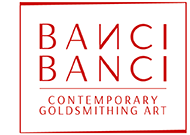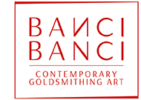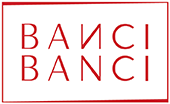Quando hai scelto l’oreficeria per esprimere la tua creatività ed hai capito che era la passione della tua vita?
Nata a Pesaro ho conseguito il diploma di Arte Applicata dei Metalli ed Oreficeria presso l’Istituto di Arte di Fano, da tempo centro di sperimentazione didattico di un grande artista come Edgardo Mannucci (Fabriano 1904 – Arcevia 1986). Fin da bambina ho avuto la passione di proseguire un cammino d’arte. A quindici anni durante gli studi superiori ho frequentato il laboratorio di Alberto Giorgi, allievo di Mannucci, dove ho sviluppato la pratica orafa ed ho elaborato un personale linguaggio espressivo, incentrato sulla progettazione e costruzione di oggetti a tre dimensioni. Nel 1981, a vent’anni ho condiviso lo studio e il laboratorio orafo ‘Banci Gioielli’ insieme a mia sorella Marzia dove ho dato vita a gioielli ‘in divenire’: forme in movimento mai fisse e uguali.
In seguito, ho conseguito la laurea in architettura presso lo I.U.A.V. (Istituto Universitario di Architettura di Venezia) approfondendo la materia che meglio esprimeva la mia passione per la progettazione e le forme, i numeri ed i simboli che intimamente li legano e che sono l’alfabeto del mio pensiero creativo, il mio modo di comunicare con segni concreti e visibili.
Quale filosofia ti guida nella realizzazione delle tue opere?
Il processo creativo nelle mie opere si manifesta, forse, nello studio costante della scultura e dell’architettura del passato e della contemporaneità e nella meditazione del testo del Concilio Vaticano II che esalta la nobile bellezza e la semplicità dello spazio sacro.
La ricerca è per me un ideale ricorrente nel riuscire a realizzare opere che si liberano come piccole architetture nello spazio. La luce penetra in quello spazio filtrando e concentrando i suoi raggi e il chiaroscuro del rilievo si trasforma così in una accentuata azione luministica.
L’elemento comunemente associato alle strutture semplici è la geometria: le forme ideali che l’uomo ha sempre prodotto sono sfere, piramidi, coni e cubi, sono le piramidi di Egitto, la geometrica perfezione dei minareti a spirale dell’Iraq o la cupola del Brunelleschi a Firenze. Attraverso il disegno e la fase progettuale mi piace inventare anche i procedimenti tecnici che poi utilizzo.
C’è un movimento intellettuale al quale ti sei riferita e/o ti riferisci?
Ho indagato lo spazio e la forma studiando i satelliti medicei e gli appunti di filosofia del Libro dell’Universo di Galileo Galilei, quell’universo che “non può essere inteso se prima non si impara a intendere la lingua, a conoscere i caratteri né quali è scritto. Esso è scritto in lingua matematica, e i caratteri sono triangoli, cerchi ed altre figure geometriche, senza i quali mezzi è impossibile a intenderne umanamente parola”. Leggo anche un breve trattato astronomico che Galileo pubblica nel 1610, il Sidereus Nuncius, il primo lavoro scientifico basato su osservazioni fatte con il telescopio. Nell’opera Galileo descrive le sue scoperte: la superficie imperfetta della luna e del suo movimento fra luce ed ombra, le centinaia di stelle che l’occhio nudo fino ad allora non aveva potuto vedere e le lune di Giove.
Ispirata dallo scienziato e dalle sue scoperte ho realizzato una serie di gioielli che gli rendono omaggio e che sono stati esposti alla mostra Galileo ed il Libro dell’Universo nel 2009 nel Centro Culturale San Gaetano di cui ho curato il progetto di allestimento e l’esposizione. Nell’ambito della stessa manifestazione ho curato il Concorso Regionale per gli studenti delle scuole superiori ad indirizzo artistico nell’anno Internazionale dell’Astronomia.
Parli spesso di Cosmo, di Cielo e di Universo. Che cosa significa?
Di notte guardo sempre il cielo, osservo le stelle che brillano e cerco un ‘viaggio’ nell’Universo, le tracce di quel percorso, cerco di coglierne il suono dell’Universo che mi si rivela. Trasferisco queste sensazioni nei miei gioielli che esprimono levità e vibrazioni che ci conducono alla musica, alla luce ed al suo contrasto con l’ombra. La luce non pesa, ma da forma e trasforma gli elementi che considero basilari nella resa del mio lavoro fatto di proporzione, di armonia e di rigore geometrico.
Come si sviluppa nella tua mente una collezione di gioielli?
Nei miei gioielli si congiungono elementi fisici e spirituali – le Mani, la Mente e il Cuore – con quelli spaziali, la Luce e il Sole. Raccolgo suggestioni, creo un racconto riunendo gli elementi che lo compongono e do inizio al processo progettuale che mi permette di sviluppare l’idea, soprattutto attraverso il disegno: descrivo la collezione che via via si sta realizzando. Talvolta però la narratività all’interno dell’oggetto si definisce soltanto alla fine, quando l’opera è compiuta. Il materiale entra in gioco in un fase molto precoce ed anch’esso ha una narratività molto importante. Addirittura in alcuni gioielli capita, che sia la materia prima a generare la collezione, ponendosi in termini dialettici ma spesso anche in termini di contrasto e di lotta con la tecnica e con l’idea di partenza. Invenzione Tecnica e Materiali sono essenziali e vengono indagati e valutati a lungo come mezzi per giungere ad un fine. E’ come addentrarsi in un percorso di scoperte, dove si ha la sensazione di voler comprendere qualcosa la cui immagine non è ancora ben definita. L’atto della costruzione si esprime dunque attraverso l’invenzione, la tecnica e la materia. Suoni, disegni e materiali sono componenti indispensabili per leggere il progetto nel suo insieme. Si crea così un criterio di unità, forma e struttura proprio come nella musica.
Il gioiello può vivere anche da solo oppure ha valore solo quando è indossato?
Le mie opere di orafo-architetto non sono mai fini a se stesse: la loro forma è conseguenza di una lunga elaborazione interiore, di una operazione puramente mentale che si relaziona costantemente con l’ambiente, con le persone, con la storia, con il materiale, e possono essere interpretate in modi diversi.
La tua produzione ha attraversato fasi diverse o è una evoluzione omogenea?
Nella mia produzione posso distinguere varie fasi che corrispondono alle Collezioni che negli anni ho realizzato, cercando di essere sempre orafa. Si identificano con questi titoli: I Colori del Desiderio; Geodedica; Entelechia Ruah; Parto; Il Cielo per una Stella; Underground.
In una di queste fasi hai indagato anche lo spazio sacro e quello spirituale.
Certamente. Con la lettura del testo del Concilio Vaticano II sono riuscita ad avere stimoli per realizzare alcuni dei miei gioielli come: Cupola e Skyline dove ho indagato lo spazio come elemento più vivo di tutto quello che ci circonda: pieno di vita, di movimento, di ritmo.
In questi ultimi anni il tuo lavoro, la tua produzione in che sedi sono stati mostrati?
Nel 2014 ho partecipato alla Mostra Gioielli d’Artista. La Tradizione nella Modernità presso lo Spazio Mostre dell’Ente Cassa di Risparmio di Firenze e al Museo Horne di Firenze. In questa occasione tra le mie opere ho esposto anche sculture gioiello realizzate in collaborazione con il ceramista-sculture fiorentino Paolo Staccioli. Ho donato ai cavalli, soggetti ‘classici’ di Staccioli, valori preziosi e nuove dimensioni afferenti allo spazio, al cielo, al fluire circolare del tempo, al volo. I cavalli di Staccioli sono diventati alati e si librano nel cielo, richiamando il mito.
I miei gioielli sono stati esposti in mostre personali e collettive in città italiane e straniere come Venezia, Firenze, Vienna, Graz, Monaco di Baviera, Londra, Istanbul, Taipei, Parigi e Tokyo.
Dal 2011 una mia opera fa parte delle collezioni permanenti del museo degli Argenti di Palazzo Pitti a Firenze.



